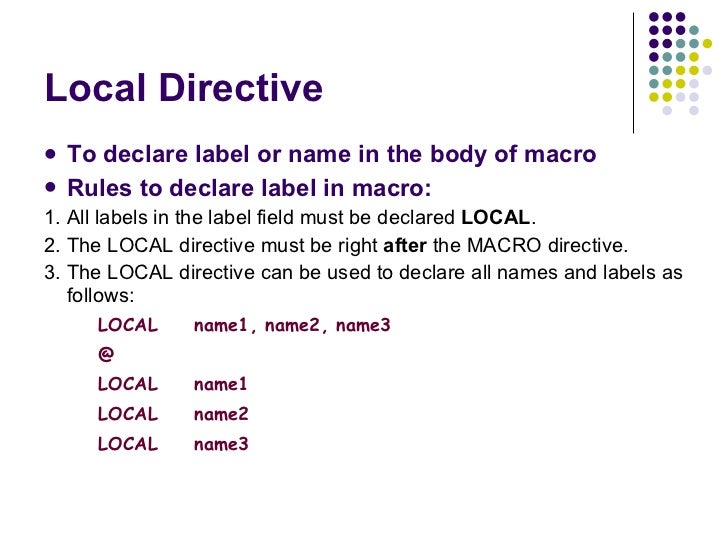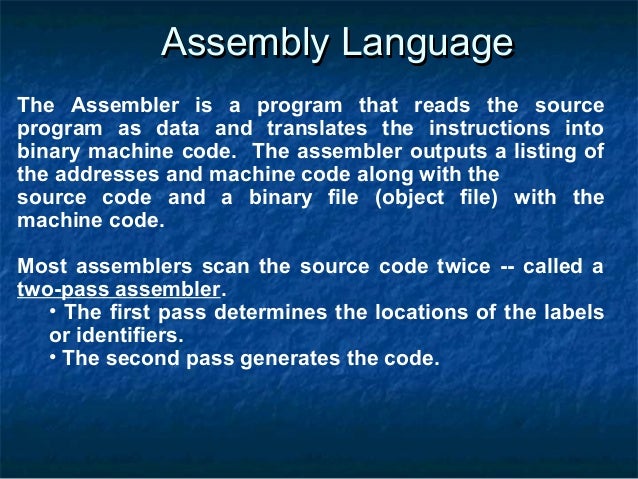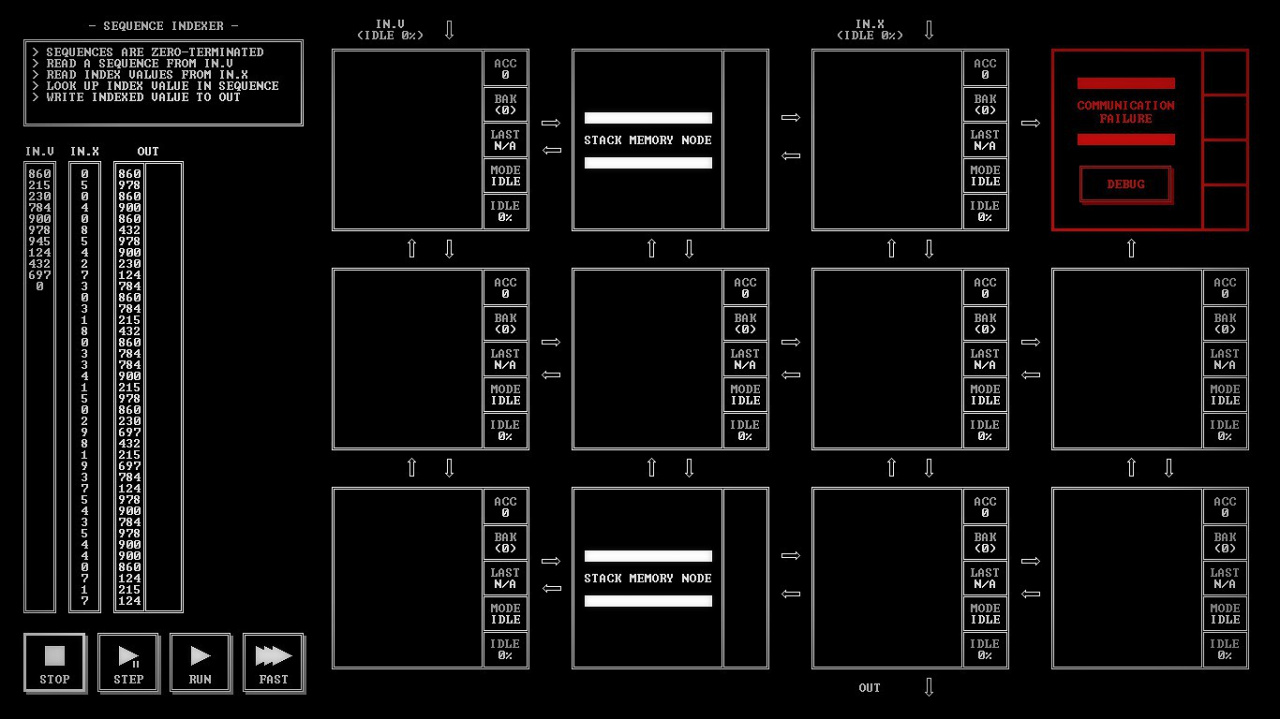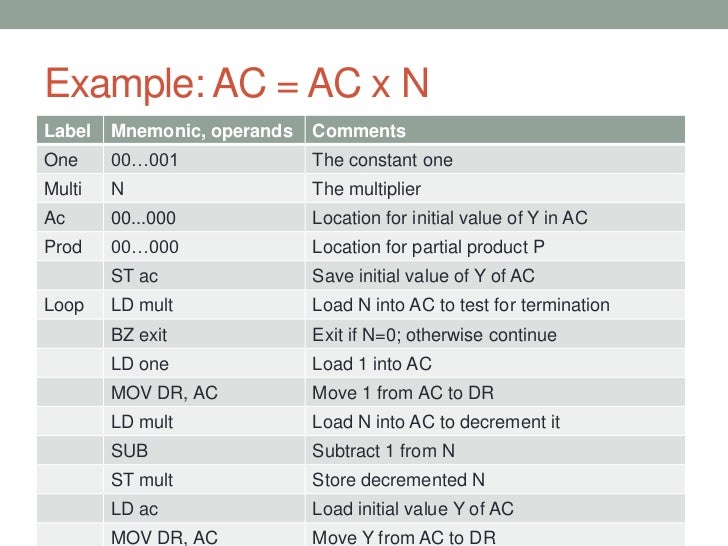44 labels in assembly language examples
Compiler User Guide: Assembler labels - Keil Non-Confidential PDF versionARM DUI0375H ARM® Compiler v5.06 for µVision® armcc User GuideVersion 5Home > Language Extensions > Assembler labels 8.36 Assembler labels Assembly labels specify the assembly code name to use for a C symbol. For example, you might have assembly code and C code that uses the same symbol name, such as counter. What are Labels in assembly language? - Quora The label is in fact a shorthand for skipping the manual calculation of the number of bytes to add to or subtract from the index pointer, for jump to label means just setting the new place in the memory the execution should continue at, ip+ or - some value.
Labels and Mainframe Assembler Macro Usage Macro with Branch & Labels The following examples will show how to use Macro Files that will generate code with Branch Instructions and unique labels. Branch with a Specified Label Using explicit names in the mainline code creates code that is simple and easy to understand.

Labels in assembly language examples
Assembly language - Wikipedia Assembly language usually has one statement per machine instruction (1:1), but constants, comments, assembler directives, symbolic labels of, e.g., memory locations, registers, and macros are generally also supported. Assembly code is converted into executable machine code by a utility program referred to as an assembler. Assembly Language Syntax by Valvano Examples. Assembly Language Syntax Programs written in assembly language consist of a sequence of source statements. Each source statement consists of a sequence of ASCII characters ending with a carriage return. Each source statement may include up to four fields: a label, an operation (instruction mnemonic or assembler directive), an operand ... PDF Computer Organization and Assembly Language • Directives have a syntax similar to assembly language but do not correspond to Intel processor instructions. • Directives are also case-insensitive: • Examples.data.code name PROC Instructions • An instruction in Assembly language consists of a name (or label), an instruction mnemonic, operands and a comment • The general form is:
Labels in assembly language examples. Assembler User Guide: Labels - Keil 7.6 Labels A label is a symbol that represents the memory address of an instruction or data. The address can be PC-relative, register-relative, or absolute. Labels are local to the source file unless you make them global using the EXPORT directive. PDF Graded ARM assembly language Examples - AlanClements Graded ARM assembly language Examples These examples have been created to help students with the basics of Keil's ARM development system. I am providing a series of examples that demonstrate the ARM's instruction set. These begin with very basic examples of addition. If any reader has difficulties with this material or can suggest retro computing - How do labels execute in Assembly ... Labels are only used during assembly and do not generate any code. They do not "contain" anything or "execute" in any way. A function in assembly typically starts with a label, so that you can refer to the function by its name instead of having to figure out the address yourself. PDF LC3 Assembly Manual and Examples - Georgetown University The above listing is a typical hello world program written in LC-3 assembly language. The program outputs "Hello World!" to the console and quits. We will now look at the composition of this program. Lines 1 and 2 of the program are comments. LC-3 uses the semi-colon to denote the beginning
Jumping to Labels in Inline Assembly | Microsoft Docs Labels defined in __asm blocks are not case sensitive; both goto statements and assembly instructions can refer to those labels without regard to case. C and C++ labels are case sensitive only when used by goto statements. Assembly instructions can jump to a C or C++ label without regard to case. The following code shows all the permutations: C++ What Is Assembly Language (With an Example) | Indeed.com In this example, "1:" is the label, which lets the computer know where to begin the operation. The "MOV" and "ADD" is the mnemonic command to move the number 3 into a part of the computer processor where it can function as a variable. "EAX," "EBX" and "ECX" are the variables. The first line of code loads 3 into the register "eax." PDF Assembly Language Tutorial 60 00111100 +42 00101010 102 01100110 A negative binary value is expressed in two's complement notation. According to this rule, to convert a binary number to its negative value is to reverse its bit values and add 1. Example: Label (computer science) - Wikipedia In assembly language labels can be used anywhere an address can (for example, as the operand of a JMP or MOV instruction). Also in Pascal and its derived variations. Some languages, such as Fortran and BASIC, support numeric labels. Labels are also used to identify an entry point into a compiled sequence of statements (e.g., during debugging ).
labels in assembly language examples In example-1, when first time program runs, A gets value 25, and then when R2 decrements from 10 to 1, output is 275 instead of 250. procedures or labels. Provide examples of three different instruction mnemonics. 10/7/2012 GC03 Mips Code Examples Conditional Branch Instructions - using labels calculating offsets is difficult - use a label instead! PDF Chapter 3 Assembly Language Fundamentals Assembly Language Fundamentals 3.1 Basic Elements of Assembly Language 51 3.1.1 Integer Constants 52 3.1.2 Integer Expressions 52 ... • memory (data label): ex. count Examples of assembly language instructions having varying numbers of operands • No operands stc ; set Carry flag • One operand What are Labels in assembly language? - Quora Jan 29, 2019 — They are simply symbols for addresses. You don't want to use direct addresses in Assembly, both because you mostly don't want to set them hard (you want your ...3 answers · 0 votes: They are a human convenience. Code execution follows (in x86) the code segment - index ...How Are Labels Named In Assembly Language?1 answerApr 26, 2019Why do we need a label to start in assembly language ...1 answerDec 25, 2018In machine language, what is the purpose of a label?1 answerJul 4, 2019More results from PDF Lecture 5 Basic Elements of Assembly Language Data Labels : a data label identifies the location of a variable, providing a convenient way to reference the variable in code. The following, for example, defines a variable named count: count DWORD 100 The assembler assigns a numeric address to each label. It is possible to define multiple data items following a label.
SECTION V-10: Rules for Labels in Assembly Language ... The names used for labels in assembly language programming consist of alphabetic letters in both upper and lower case, the digits 0 through 9, and the special characters question mark (?), period (.), at (@), underline (_), and a dollar sign ($). The first character of the label must be an alphabetic character.
pic microcontroller assembly language programming examples For example MOVLW is an Opcode. Labels. A label is an identifier used to represent a line in code or section of a program. Goto statements can be used in conjunction with a Label to jump to the execution of code identified by the particular label. See Task 1 code for example. ... pic microcontroller assembly language examples 6.
Assembly Language Style Guidelines - Instructions All identifiers appearing in an assembly language program must be descriptive names whose meaning and use are clear. Since labels (i.e., identifiers) are the target of jump and call instructions, a typical assembly language program will have a large number of identifiers.
Labels (x86 Assembly Language Reference Manual) When a numeric label is used as a reference (as an instruction operand, for example), the suffixes b ("backward") or f ("forward") should be added to the numeric label. For numeric label N, the reference Nb refers to the nearest label N defined before the reference, and the reference Nf refers to the nearest label N defined after the reference.

Assembly Language Instructions With Examples | Introduction | C, C++, and Assembly Language ...
LC3 Assembly Language.ipynb - Bryn Mawr College LC3 Assembly Language¶. More abstract, with additional powers: Labels; Instruction and Register names; Assembler Directives.ORIG - location to store code/data.END - end assembly process.FILL - Value for this memory location.BLKW - Block of Words.STRINGZ - Initialize memory with ASCII values, 0-terminated; Shorthand for using decimal and hexadecimal numbers
Assembly Language NOW, Under21, R2D2, and C3PO are all examples of possible LC-3bassembly language labels. There are two reasons for explicitly referring to a memory location. 1. The location contains the target of a branch instruction (for example, AGAIN in line 0E). 2.
Assembly Language Programming • ECEn 323: Computer ... Assembly language is more readable than the binary machine code and is easier to edit and manipulate. The purpose of the "assembler" is to translate the text assembly language file written by a human into binary machine code executed by the processor (See section 2.12 in the textbook). This process is tedious and best left to a computer.
"Label" in Assembly language - Stack Overflow Sep 12, 2014 — A "LABEL" is something so that you don't have to manually work out the addresses to jump to. It is not an instruction and takes up no space ( ...2 answers · Top answer: and when 10 times DJNZ adds 25 in A it should come out to be 275 No, 250 is the correct ...Difference between label and fuction in assembly - Intel syntaxMar 21, 2020How do labels execute in Assembly? - Stack OverflowFeb 2, 2021What is the function of a "data label" in an x86 assembler?Jun 25, 2017Labels and Variables in Assembly? - Stack OverflowOct 7, 2021More results from stackoverflow.com
2 Assembly Language Programming - University of New Mexico In an assembly language program, a label is simply a name for an address. For example, given the declarations shown in Example 2.1, ``x'' is a name for the address of a memory location that was initialized to 23. On the SPARC an address is a 32-bit value. As such, labels are 32-bit values when they are used in assembly language programs.
PDF Assembly Language Programming - UTEP - Labels are symbols - Labels must begin in column 1. - A label can optionally be followed by a colon - The value of a label is the current value of the Location Counter (address within program) - A label on a line by itself is a valid statement - Labels used locally within a file must be unique. Adapted from notes from BYU ECE124 5
SimpComp Assembly Language If present, a label consists of up to fourteen characters with a terminating colon (15 total). A label must begin with an alpha character but all subsequent ...DIRECTIVE: OPERANDS
Labels · Bushra-KB/X86AssemblyLanguageExamples · GitHub These examples are designed for intel 8086 microprocessor. MASM and emu8086 assembler's syntax are used in the programs. It is for learning purpose. - Labels · Bushra-KB/X86AssemblyLanguageExamples
Embedded Systems - Assembly Language - Tutorialspoint The names used for labels in assembly language programming consist of alphabetic letters in both uppercase and lowercase, number 0 through 9, and special characters such as question mark (?), period (.), at the rate @, underscore (_), and dollar ($). The first character should be in alphabetical character; it cannot be a number.
Example of Assembly - University of Aberdeen In this example, the assembler would always replace START with 1016. Hence you could write : START EQU 10 ORG START GOTO 10 The assembler would translate START as 10, and load the code at $10, as before. The use of labels often makes a programme easier to understand and to modify.
PDF Computer Organization and Assembly Language • Directives have a syntax similar to assembly language but do not correspond to Intel processor instructions. • Directives are also case-insensitive: • Examples.data.code name PROC Instructions • An instruction in Assembly language consists of a name (or label), an instruction mnemonic, operands and a comment • The general form is:
Assembly Language Syntax by Valvano Examples. Assembly Language Syntax Programs written in assembly language consist of a sequence of source statements. Each source statement consists of a sequence of ASCII characters ending with a carriage return. Each source statement may include up to four fields: a label, an operation (instruction mnemonic or assembler directive), an operand ...
Assembly language - Wikipedia Assembly language usually has one statement per machine instruction (1:1), but constants, comments, assembler directives, symbolic labels of, e.g., memory locations, registers, and macros are generally also supported. Assembly code is converted into executable machine code by a utility program referred to as an assembler.











Post a Comment for "44 labels in assembly language examples"